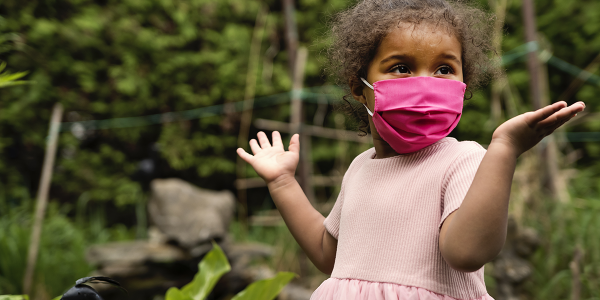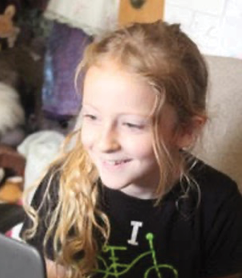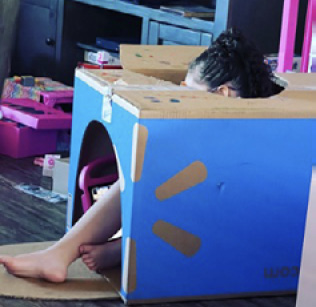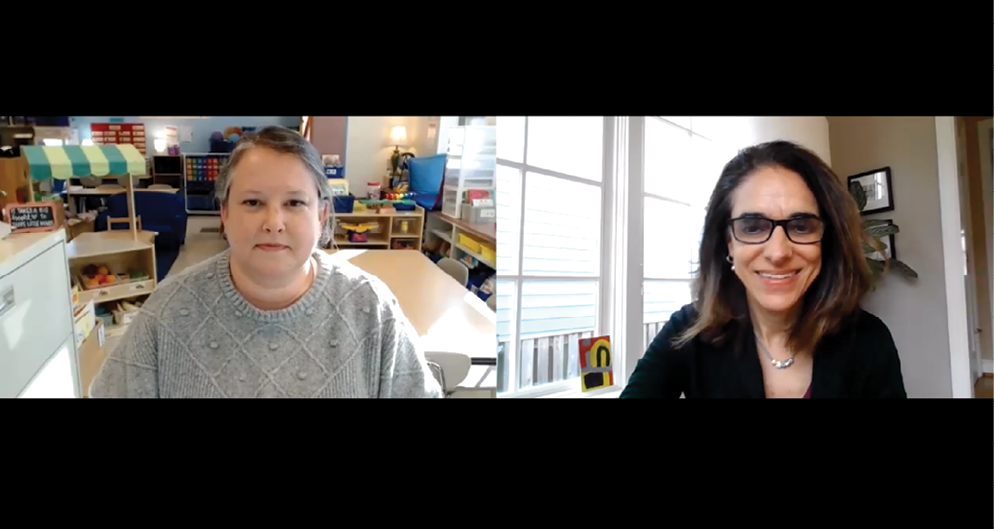DAP During the Time of COVID: Opportunities for Joyful, Engaged Learning

You are here
Editors’ Note
The release of NAEYC’s updated position statement on developmentally appropriate practice happened just before the world and the field of early childhood education began to navigate and feel the impacts of the COVID-19 pandemic. So many questions emerged during that time for educators, families, policymakers, and others involved in the education and care of young children. One fundamental question was, what is developmentally appropriate in the time of COVID?
Because the concept of joyful learning permeates the revised DAP position statement, Susan Friedman, NAEYC’s senior director of publishing and content development, connected with early childhood educators about what DAP in a tough year can look and sound like. In this special feature, we highlight some of their stories and lessons learned. The first piece, posted on the NAEYC blog in January 2021, showcases two virtual-learning moments. Julia Luckenbill and Nicol Russell are early childhood educators and mothers who captured DAP in action with their children. Susan provides an opening and closing reflection. The second piece is an excerpt (edited for style and length) of Susan’s conversation with Amy Blessing, a kindergarten teacher in North Carolina, in early 2022 about how DAP is guiding what North Carolina schools have been doing over the course of the pandemic.
Both pieces speak to the unforeseen challenges to and opportunities for children’s joyful, engaged learning in the midst of a global pandemic. The discoveries and themes in each piece also highlight what is possible with DAP for beyond the pandemic.
The recently updated “Developmentally Appropriate Practice” position statement emphasizes the importance of engaged, joyful learning. But what does engaged, joyful learning look like during a time when many early learning programs around the country are struggling, and educators, families, and children are navigating virtual school and social distancing? As I pondered this question, I thought of two different photos that two different educators/moms snapped of their children during virtual school. To me, these represent joyful learning.
The first photo is of a 7-year-old second grader, who is smiling ear to ear while leading her class in a game of Twenty Questions. In this example, joyful learning is part of a carefully planned learning activity with a number of learning goals embedded in a fun, engaging game the children can play with each other virtually.
The second photo is of a cardboard “car” with a small glimpse of a 5-year-old kindergartner, who decided to attend virtual school from “inside her car.” The photo wonderfully captures the pride, joy, comfort, and agency a child experiences when engaged in self-directed play. While her work on transforming the box into a house and then a car took place outside of school, her mom and teacher allowed her the ownership and agency to decide to incorporate her creation into her virtual classroom. Although both examples represent different kinds of play, the first a game and the second self-directed, in both cases a picture is worth 1,000 words.
Joyful learning is part of a carefully planned learning activity with a number of learning goals embedded in an engaging game the children can play with each other virtually.
A Second Grader Leads Twenty Questions
Julia Luckenbill described the moment she captured during her daughter’s school day.

Julia’s second grader is in the midst of her virtual school day when she runs from her desk wearing an ear-to-ear grin. “My teacher says I can lead the Twenty Questions game! I always wanted to be the one who gets to answer the question!” She sorts through various toys, considering the kinds of objects her first-grade teacher used to stump the class last year. She selects a pirate eye patch and bags it. When it’s time to play, she holds up the bag, and they are off.
Classmate: “Is it a toy?”
Focal child: “Kinda . . .”
Another classmate: “Is it a stuffie?”
Focal child: “Noooo!”
Her teacher, Mrs. Davis, gives the class tips, saying, “You can ask her things like, ‘Is it big or small?’” To which Julia’s child replies, “It’s small.”
The children successfully discover that the mystery item has elastic and is blue, but they end up stumped. Victorious, Julia’s second grader reveals the pirate eye patch and puts it on. Now many other children want to lead the game. It’s time for breakout rooms, and as her daughter clicks on the room she is assigned to, the students begin to chat.
One student asks, “What shall we play?” Another replies, “Let’s do Twenty Questions!”
The first student runs off screen, hunting for his own mystery item. The children’s learning is self-directed, engaged, and joyful.
Julia highlighted that this moment, captured in a photo, represents joyful learning because to the children, Twenty Questions looked and felt like play. As they played, the teacher was able to use the moment to achieve a number of learning goals:
- Children refined on-task behaviors such as following directions and raising hands.
- They developed listening skills that they used to process information from clue givers.
- They developed and used descriptive language to give clues and ask questions.
- They used cognitive skills as they activated prior knowledge and made logical predictions based on the clues gathered.
- They used previous experiences to communicate clearly with their peers and teacher.
Refining their communication skills using all these tools will help them to participate effectively in small- and large-group discussions, not only during this game, but in other activities.
Julia loved that the activity led to home-to-school connections in their household because, of course, they must play the same game again. Repetition in a range of settings allowed her daughter to use these skills easily and confidently.
Julia knew that her daughter still missed seeing her friends at school and being in the physical classroom. But her teacher infused the virtual classroom with enthusiasm and love, and it showed in this moment and every day since then. She gave the children the tools they needed to make it through the pandemic: humor, interaction and communication, play, and a bit of suspense too.
Her teacher infused the virtual classroom with enthusiasm and love, and it showed in this moment and every day since then.
It’s not the same, but this virtual classroom built community and resilience through joyous engaged interactions.
A Kindergartner Attends Virtual Class from Her “Car”
Nicol Russell described the moment she captured during her 5-year old daughter’s school day.
 On her first day back in virtual class after five weeks of attending kindergarten in person, Nicol’s 5-year-old attends virtual school from her “car.”
On her first day back in virtual class after five weeks of attending kindergarten in person, Nicol’s 5-year-old attends virtual school from her “car.”
A few days before this picture was taken, her daughter turned the box into a house. She became frustrated that the house was too small for her (she’s a tall 5-year old), so she asked for help cutting a hole in the top. Nicol thought it was for a roof for her house, but she said, “No, it’s a car now, with the top that opens.”
On this day, Nicol’s daughter simply announces that she will be working in her car for school.
Nicol was not actually sure what her child’s teacher may have seen or thought that day. In general, Nicol tries to let her daughter be as independent as possible while she is doing her schooling, so unless she needs assistance, Nicol doesn’t interact with the teacher while her daughter is online.
To Nicol, this represents joyful learning because her daughter was able to be as comfortable as she wanted to be while attending virtual class in a structure she conceived of and created herself. She doesn’t know what could be more joyful than enjoying the fruit of one’s labor.
A Reflection on These Joyful Moments
In both these examples, there was a great deal of trust between parent and teacher, parent and child, and teacher and child. In the case of the game Twenty Questions, children left their virtual classroom to run and find objects around the house. The teacher also trusted one child to lead an activity rather than having every activity led by the teacher.
In the second example, the family and teacher worked as a team to support a child in feeling some control as she engaged in her virtual classroom. Both her family and teacher considered how to invite her to express her unique ideas in the space, and they allowed her to make decisions about how she would be most comfortable and engaged, thinking outside (or inside) of the box.
When teachers and families work together, the virtual classroom is enriched by the things families bring to the screen, whether it be creative ways to view the lesson, peering at pirate eyepatches, or something else entirely—favorite decorations, beloved books, pets, and more. Encouraging the children to bring their stories into the virtual classroom brings joy. These learners are lucky to have teachers who understand that children need to individualize their experiences in order to feel control during a challenging time.
Readers may ask: Is sitting in a box developmentally appropriate while attending virtual school? Would Twenty Questions be developmentally appropriate with younger children? As the position statement points out, nothing is developmentally appropriate in and of itself. Educators make curriculum decisions that support the children they are engaging. To do this, they consider many things—family backgrounds and cultures, families’ lived experiences, which things can’t be translated to a digital world and which can still be a part of the curriculum, as well as the children’s ages. Teachers must integrate their district’s curriculum expectations using their own unique style. No wonder each classroom will look unique, and each may inspire joyful learning in its own way.
About the Authors
Susan Friedman is senior director, publishing and content development at NAEYC.
Julia Luckenbill, MA, is the director of programming for the Davis Joint Unified School District’s parent participation nursery school at the Danbury site.
Nicol Russell is the vice president of Implementation Research for Teaching Strategies, LLC. She is also currently serving as a NAEYC board member.
How DAP Can Serve as a Guide When Navigating Change
Susan Friedman, Amy Blessing
 Susan: In this interview, I’m talking about developmentally appropriate practice (DAP) with Amy Blessing, who is a kindergarten teacher in North Carolina schools. She also provided some input and acted as a reviewer on the fourth edition of the Developmentally Appropriate Practice book.
Susan: In this interview, I’m talking about developmentally appropriate practice (DAP) with Amy Blessing, who is a kindergarten teacher in North Carolina schools. She also provided some input and acted as a reviewer on the fourth edition of the Developmentally Appropriate Practice book.
Amy, in our conversation ahead of this interview, you mentioned to me the idea of children having things decided for them last year and that you were working on offering children opportunities for choice. Talk a little bit about that.
 Amy: Choice is a big part of our kindergarten day, a big part of helping children feel autonomous in their learning and in their experiences. And I think that really helps them develop a lot of important skills that they need for life.
Amy: Choice is a big part of our kindergarten day, a big part of helping children feel autonomous in their learning and in their experiences. And I think that really helps them develop a lot of important skills that they need for life.
When I think about last year, we had those six-foot bubbles. We had the plastic partitions, and we had the stickers in the hallway six feet apart. Children had to walk on the spacing just like you would see when you go into stores (where they had the spaces on the floor). They didn’t have to decide a lot of things last year because it was decided for them.
I’m really trying to be intentional with how I can give them choice this year, still within some of the restrictions that we have in place. We’re trying to be a lot more careful with being aware of who spends significant amounts of time together.
So I’m trying to think about how am I offering choice, whether it’s student-led activities, student-led play, or more in teacher-directed activities. I’m using a lot of digital choice boards this year—giving them choices, but then being able to keep track of where they’re working. So I can go back and do some contact tracing if I have to, in the world that we are in right now with COVID.
I am trying to help them navigate choices of where to sit on the carpet. Last year, some classrooms didn’t even have carpets, and we didn’t get ours until the spring where we could gather together on the carpet area. That’s a skill that has to be developed: How do we share space together? How do I sit down in a space that my teacher didn’t tell me where to sit, but how can I find a space and work?
I’m really trying to be intentional with how I can give them choice this year, still within some of the restrictions that we have in place.
Lining up, sitting together—those are opportunities to develop self-regulation. Something that really struck me last year is that I had somebody comment on how well-behaved my class was in the hallway. And I was thinking that they are on stickers six feet apart, so they don’t have to develop [self-regulation skills]: How do I stand next to somebody without bumping into them? How do I make that choice to be kind to the people around me? So we’re trying to be really intentional with helping children develop the skills.

We think a lot about variety of materials and choice—what kinds of things are going to keep children interested, what are they going to choose to work on? I’ll put out a variety of things to give them choice throughout the day. And then trying to be really careful and intentional and reflective with use of technology. Last year, we were one-to-one with devices. We used technology a lot throughout the day because we were all in our six-foot bubbles. So there’s a lot of things that we became really skilled at how to do on the Chromebook, ways to switch our lessons we could do using technology. This year, we’re really trying to be reflective—now that we’re back in the classrooms, how can I provide that same opportunity in a hands-on way? Because our children really need to have hands-on, real materials that they’re working on. There are a lot of things that we can do with technology, but really being careful, is there another way that I can provide that for them?
About the Participants
Susan Friedman is senior director, publishing and content development at NAEYC.
Amy Blessing, MEd, NBCT, is a kindergarten teacher with Pender County Schools in eastern North Carolina.
NAEYC Resources About COVID-19
For more information about teaching and learning during the pandemic, visit NAEYC’s blog at NAEYC.org/resources/blog and NAEYC’s resources about coping during COVID-19 at NAEYC.org/resources/topics/covid-19.
Photographs: courtesy of the authors; © Getty Images; © NAEYC
Copyright © 2022 by the National Association for the Education of Young Children. See Permissions and Reprints online at NAEYC.org/resources/permissions.
Susan Friedman is Senior Director, Publishing and Professional Learning at NAEYC.
Julia Luckenbill, MA, is the director of programming for the Davis Joint Unified School District's parent participation nursery school at the Danbury site.

Nicol Russell is the vice president of Implementation Research for Teaching Strategies, LLC. She is also currently serving as a NAEYC board member.
